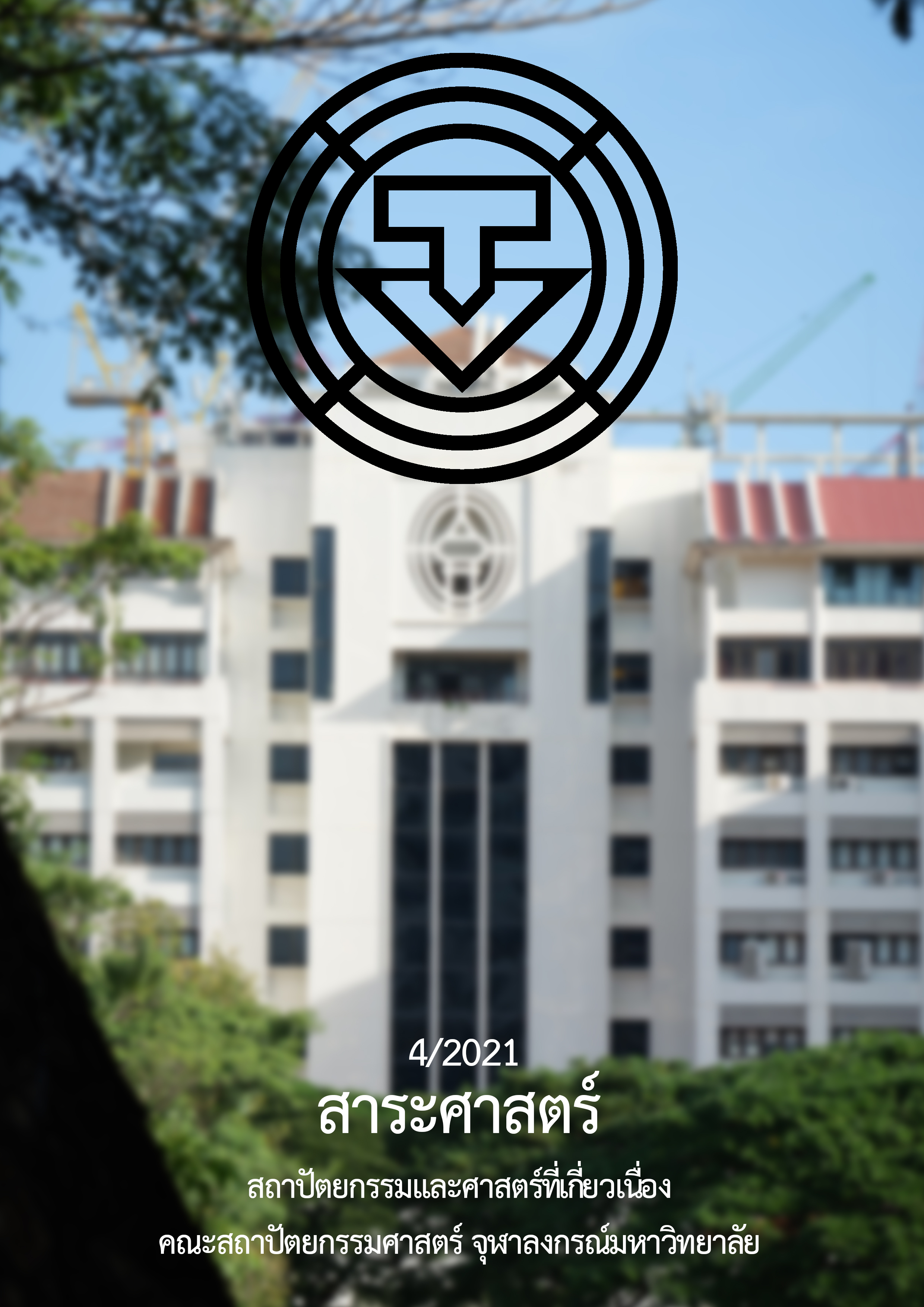วิธีจัดการปัญหาและรูปแบบทางกายภาพที่พักอาศัยชั่วคราวสำเร็จรูป : กรณีศึกษาบริษัทอิตาเลียนไทยดีเวล๊อปเมนต์ จำกัด (มหาชน)
Main Article Content
บทคัดย่อ
ที่พักอาศัยชั่วคราวที่ทางบริษัทรับเหมาก่อสร้างจัดหาให้กับพนักงาน และแรงงานก่อสร้างนั้น ส่วนใหญ่บริษัทรับเหมาก่อสร้างรับหน้าที่ในการจัดเตรียมที่พักให้เป็นแหล่งพักอาศัย บริษัทมักเลือกพื้นที่ใกล้กับหน่วยงานก่อสร้าง เพื่ออำนวยความสะดวกให้กับพนักงานและเป็นสวัสดิการให้กับแรงงานในหน่วยก่อสร้างดังกล่าว โดยในปัจจุบันบริษัทอิตาเลียน-ไทยดีเวล๊อปเมนต์ จำกัด (มหาชน) ได้พัฒนาที่พักอาศัยชั่วคราวสร้างใหม่เป็นรูปแบบสำเร็จรูปทั้งหมด เพื่อคุ้มทุนในระยะยาว และสะดวกในการเคลื่อนที่ไปยังพื้นที่ก่อสร้างอื่น แต่อย่างไรก็ดี พบว่าผู้พักอาศัยมักจะต่อเติมดัดแปลงพื้นที่พักอาศัยบริเวณของตนเอง ทำให้ที่พักอาศัยชั่วคราวสำเร็จรูปนั้นเกิดการเสียหายขึ้นจากการต่อเติมดัดแปลงดังกล่าว งานวิจัยฉบับนี้มีวัตถุประสงค์เพื่อศึกษารูปแบบทางกายภาพ โดยการรวบรวมข้อมูลด้านกายภาพของที่พักอาศัยชั่วคราวสำเร็จรูป ให้ทราบถึงรูปแบบการพักอาศัย ปัญหาในการพักอาศัย รวมไปถึงสาเหตุในการดัดแปลงที่พักอาศัยซึ่งมีวิธีการวิจัยคือสำรวจสภาพกายภาพ จำนวน 147 ห้องพักและเก็บข้อมูลโดยการสัมภาษณ์ผู้พักอาศัยในกลุ่มตัวอย่างจำนวน 35 ห้องพักครอบคลุมตั้งแต่ระดับหัวหน้างานถึงคนงานก่อสร้าง หลังจากนั้นจึงนำผลสรุปมาวิเคราะห์ข้อมูลเพื่อเสนอแนวทางวิธีจัดการปัญหาต่อไป จากการศึกษาพบว่าลักษณะการใช้งานที่กระทบต่อที่พักอาศัยชั่วคราวในระยะยาวกรณีที่ต้องเคลื่อนย้ายไปยังพื้นที่อื่น คือ การ
ต่อเติมดัดแปลง กันสาด ราวตากผ้า Flashing กันน้ำบริเวณรอยต่อแผ่นผนังภายนอก การปิดช่องแสงบริเวณหน้าต่าง การติดตั้งชั้นวางของภายในห้องพักเข้ากับแผ่นผนังและติดตั้งวัสดุกั้นห้องบริเวณเหนือแผ่นผนังภายในแต่ละห้องพัก ซึ่งสาเหตุในการดัดแปลงที่พักอาศัยคือ 1.เพื่อเพิ่มพื้นที่พักอาศัยทั้งภายใน และภายนอกห้องพักเป็นหลัก 2.เพื่อแก้ปัญหาที่เกิดขึ้นจากการใช้งานที่พักอาศัยชั่วคราวสำเร็จรูปซ้ำ และต่อเติมดัดแปลงที่พักจากพื้นที่เดิมแล้วย้ายมาติดตั้งยังพื้นที่ใหม่ รวมไปถึงการแก้ปัญหาจากสภาพแวดล้อมในการพักอาศัยของผู้พักอาศัยเอง ซึ่งส่งผลกระทบโดยตรงต่อการใช้งานที่พักอาศัยชั่วคราวสำเร็จรูปให้เกิดความเสียหายก่อนจะถึงจุดคุ้มทุนตามที่ผู้ประกอบการวางแผนไว้ งานวิจัยนี้จะเป็นประโยชน์ต่อผู้ประกอบการสามารถนำข้อมูลไปประยุกต์ใช้ในการพัฒนาที่พักอาศัยชั่วคราว และยกระดับคุณภาพชีวิตของแรงงานก่อสร้าง ซึ่งจะเป็นแรงผลักดันให้ทำงานได้อย่างเต็มความสามารถและส่งผลทางอ้อมในการยกระดับอุตสาหกรรมก่อสร้างต่อไป
Article Details
เอกสารอ้างอิง
กระทรวงดิจิทัลเพื่อเศรษฐกิจและสังคม. สำนักสถิติแห่งชาติ. (2563). Labour. สืบค้นจาก http://statbbi.nso.go.th/staticreport/page/sector/en/02.aspx
กระทรวงพาณิชย์. กรมพัฒนาธุรกิจการค้า. (2563). ข้อมูลการจดทะเบียนนิติบุคคลประจำปี. สืบค้นจาก https://www.dbd.go.th/download/document_file/Statisic/2562/H26/H26_2019.pdf
Krungsri Research. (2562). ธุรกิจรับเหมาก่อสร้างแนวโน้มธุรกิจ/อุตสาหกรรมปี 2562-2564. สืบค้นจาก https://www.krungsri.com/th/research/industry/industry-outlook/Construction-Construction-Materials/Construction-Contractors/IO/io-Construction-Contractors-21
จักรกฤษณ์ ขันติวงษ์. (2539). การพัฒนารูปแบบที่พักอาศัยชั่วคราวสำหรับคนงานก่อสร้าง: กรณีศึกษา ที่พักอาศัยชั่วคราวของคนงานก่อสร้าง บริษัท เวสท์คอน จำกัด กรุงเทพมหานคร. (วิทยานิพนธ์ปริญญามหาบัณฑิต, จุฬาลงกรณ์มหาวิทยาลัย).
ประสาร ศรีศุภชัยยา. (2539). สภาพปัจจุบันและความคาดหวังเกี่ยวกับที่อยู่อาศัยชั่วคราวและถาวรของผู้ใช้แรงงาน.(วิทยานิพนธ์ปริญญามหาบัณฑิต, จุฬาลงกรณ์มหาวิทยาลัย).
พนม ภัยหน่าย. (2543). การบริหารงานก่อสร้าง (พิมพ์ครั้งที่ 17). กรุงเทพมหานคร: สำนักพิมพ์สมาคมส่งเสริมเทคโนโลยี.
พิภพ สุนทรสมัย. (2541). การก่อสร้างอาคารขนาดใหญ่. กรุงเทพมหานคร: สำนักพิมพ์ส่งเสริมเทคโนโลยี.
รัฐธรรม แสงสุริยัน. (2548). การพัฒนารูปแบบที่พักอาศัยชั่วคราวสำหรับคนงานก่อสร้าง. (วิทยานิพนธ์ปริญญามหาบัณฑิต,จุฬาลงกรณ์มหาวิทยาลัย).
วิภาวี อังศุวัชรากร. (2562). การจัดการที่พักแรงงานก่อสร้างขนาดใหญ่ในเขตกรุงเทพมหานคร. (วิทยานิพนธ์ปริญญามหาบัณฑิต, จุฬาลงกรณ์มหาวิทยาลัย).
สมบัติ วนิชประภา. (2541). การพัฒนาที่พักคนงานในโครงการก่อสร้างขนาดใหญ่: กรณีศึกษาโครงการทางด่วนสายบางปะอิน-ปากเกร็ด. (วิทยานิพนธ์ปริญญามหาบัณฑิต, จุฬาลงกรณ์มหาวิทยาลัย).
อร่าม ลือพร้อมชัย. (2539). ความเป็นอยู่ของคนงานก่อสร้างขนาดเล็กและขนาดกลางในเขตกรุงเทพมหานคร.(วิทยานิพนธ์ปริญญามหาบัณฑิต, จุฬาลงกรณ์มหาวิทยาลัย).


